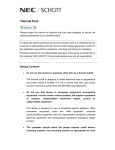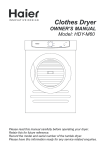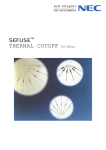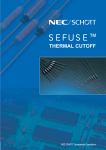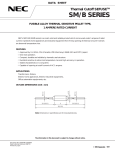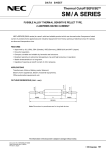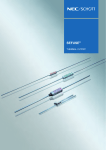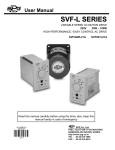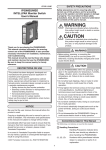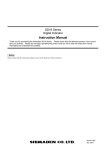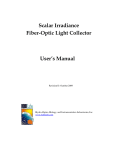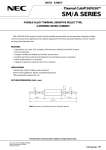Download SF Cautions
Transcript
Thermal Fuse Please review this section of cautions that has been designed to ensure the optimal performance of our thermal cutoffs. To obtain the optimal performance from the thermal cutoff, it is necessary for the customer to appropriately store the thermal cutoff, design appropriate circuits for the application and perform evaluations, mounting and testing as necessary. Problems arising from the inappropriate execution of the above are at the risk of the customer. NEC SCHOTT Components declines any and all responsibility. Design Cautions • Do not use this device for purposes other than as a thermal cutoff. The thermal cutoff is designed to detect abnormal rises in temperature and break circuits if needed. It is not a current fuse that cuts excess current. If used as a current fuse, the SEFUSE may malfunction. • Do not use this device in aerospace equipment, aeronautical equipment, nuclear reactor control systems, life support equipment or systems, transportation machinery engine control or safety-related equipment. This device is designed for use in household electric appliance, office automation equipment, audio and video equipment, computer communications equipment, test and measurement equipment, personal electronic equipment and transportation equipment (excluding engine control). • The customer should select the proper thermal cutoff device, mounting location, and mounting method as appropriate for each application. Verify whether the chosen selections are appropriate by repeatedly testing the final design for thermal cutoff under normal conditions as well as under predicted maximum abnormal conditions. • Mount the SEFUSE such that it can detect abnormal heat as quick as possible. The thermal cutoff operates when the inside thermal element melts. Therefore, if the thermal element inside does not reach the operating temperature, the thermal cutoff does not operate even if the ambient temperature rises to the operating temperature. When the ambient temperature rises suddenly or detect heat partially, it may take time till the SEFUSE operates. • Mount the SEFUSE so that the temperature is evenly distributed along every part of the device. If the SF-type(*) lead B, which is caulked to the metal case, is mounted so that it only conducts heat to the body, the temperature around the thermal pellet can be always higher than the other places in the metal case, which can cause the SEFUSE to early open. Be sure to connect the lead A, the resin-sealed side, to the heat source. Mounting the SEFUSE so that the temperature of the lead A is always lower than that of the lead B can also cause the SEFUSE to early open. (*) Except SFH type • Designs should ensure that the temperature of the thermal cutoff does not exceed the temperatures shown in Table 1. If, these temperatures are exceeded on a regular basis, the thermal cutoff may start operating only at temperatures lower than the normal operating temperature. Malfunctions may also occur. Even if the thermal cutoff's operating temperature is exceeded, it may malfunction. *1) The temperatures do not refer to ambient temperature but surface temperature of the thermal cutoff. • The SEFUSE has a limited life. Although the thermal elements are made of durable substances intended for long-term usage, their lifetime varies depending on using conditions. The more frequently SEFUSE is used at the temperature close to the operating temperature, the shorter the lifetime could be. Therefore, we recommend performing a reliability test, with the SEFUSE mounted onto the actual application, or under almost the same condition as the actual situation to assess the lifetime of the device. • The body temperature of the thermal cutoff becomes higher as a current passes through and might become even higher than the ambient operating temperature (see test data). The temperature may rise even higher depending on the mounting method and other conditions. Therefore, after mounting the thermal cutoff under the same conditions you would use for the actual application, run the final product and measure the body temperature of the thermal cutoff. • Use the thermal cutoff with a voltage and current level lower than the rated level. If the thermal cutoff is used with a voltage or current level higher than the rated level, the body of the thermal cutoff may be destroyed. • Do not use the thermal cutoff in water, organic solvents or other liquids, or environments containing sulfurous acid gas, nitrous acid gas, or high humidity. Doing so will cause deterioration of the sealing resin, the thermal cutoff may operate at lower-than-operating temperatures, or malfunctions to occur. Also, the thermal cutoff may not operate even if its operating temperature is exceeded. Lead Wire Process • When bending the lead wire, in order not to apply excessive pressure to the root of the lead wire, secure the lead wire close to the case and bend the part beyond the secured section. The lead wire should be bent at a distance of 3 mm or more from the body of the fuse, and should not be twisted. • When cutting the lead wire, cut according to the above-mentioned method. • The tensile strength applied to the lead wire should be 5kgf (49N) or less. • The strength applied to the body of the thermal cutoff should be 10kgf (98N) or less. Mounting • SEFUSE can be mounted by soldering, caulking, or welding. o It is recommended that the connecting position at the lead of resign-sealed side should be 5 mm or more from the body of the thermal cutoff. • If soldering, note that the thermal cutoff may not function because of the excessive solder temperature. To prevent such malfunctions, for example, holding the lead near the case by tool is effective for allowing the heat to escape, and soldering should be done in short intervals. Another method is to use a lower solder temperature and to solder at a location that is at a distance from the case. • If caulking or welding, be careful to keep the resistance value of the connecting section low. If the connecting section has a high resistance value, the passing current may generate an abnormally high temperature that will cause the thermal cutoff to operate (break the circuit). • It is recommended that the connecting position at the lead of resign-sealed side should be 5 mm or more from the body of the thermal cutoff. • After mounting the thermal cutoff, be careful not to apply force that may pull, push or twist the lead wires. • When using an SF type with lead forming, be sure not to make the lead on the resin-sealed side touch the case. This would cause the current to flow from the lead on the resin-sealed side to the opposite lead so that the thermal cutoff cannot break the circuit. • Note that the body of the SF type is the same in potential as the circuit. Therefore, it must be electrically isolated from the other metallic part. • When marking a thermal cutoff, there is a concern that the marking will be removed when alcohol or other organic solvents are used. There could also be an incidence whereby the marking transfers onto the insulation tube and becomes faint when the thermal cutoff is covered with it. Please confirm the above before you use any organic solvents or insulation tubes on a thermal cutoff. • In other mounting, be careful of that the thermal cutoff may not function. Confirm above before you mount for the thermal cutoff. Storage • The body and lead A are silver-plated. Therefore, these parts may discolor because of sulfuration, leading to a difficulty in discriminating the marking of the body or a decline in the solder-ability of lead. To avoid this, SEFUSE should not kept in the environment of materials (such as cardboard or rubber, etc.) which generate sulfurous acid gas. • In instances when SEFUSE needs to be stored in a cardboard box, the SEFUSE packs should be placed into other bags (such as polyethylene) and well-sealed. • Keep away from heat and moisture to avoid false operation of the thermal cutoff and sulfuration of silver plated parts. (Ref.: Temperature Max 40°C, Humidity Max 80%) Disposal Consideration • The thermal cutoff corresponds to industrial waste, so dispose it according to governmental and provincial regulations or engage the services of a licensed disposal contractor. Recommendations • We recommend the following tests upon receipt of SEFUSE and after mounting it, as it may have a mechanical load or thermal influence under transportation or when being mounted. 1) Appearance check 2) Resistance check (comparing before and after), or conductive check 3) X-ray inspection 4) Operation check for sampling • Be careful when mounting the thermal cutoff because external force, heat, or a harmful atmosphere (containing excessive humidity or sulfurous acid gas) may damage the characteristics of the thermal cutoff. If applicable, it is recommended to warn general consumers, who are not aware of the usage cautions for the thermal cutoff not to mount, remove or replace the thermal cutoff through a note to this effect in the user's manual and other related material.








